I’d like to say I planned it all with a watchmaker’s precision: that 30 years ago I consciously constructed and then embarked on a coast-to-coast mission in search of marine megafauna. In truth, it just happened. Exactly how I made the leap from snails (I obsessed over nudibranchs in college) to whales (and dolphins and sharks and…) remains a bit of a mystery. I was sucked into the slipstream of big marine life, and I’ve been happily riding there ever since.
Washington: Home Is Where You Hang Your Hood
One reason I settled in the Pacific Northwest was my burning desire to explore its invigoratingly cool emerald seas. Another reason was to meet two local icons with supersized personalities. I often joke that killer whales (orcas) and giant Pacific octopuses (GPOs) are my totem animals. You could say that they are the rack upon which I first hung the wetsuit (and very soon thereafter, drysuit) of my photography career.
My first wild encounter with the malevolent devilfish of maritime lore was in the San Juan Islands while visiting the University of Washington’s Friday Harbor Laboratories. After an animated discussion with colleagues about aggressive behavior between sea slug conspecifics, I joined a fellow “brancher” (a nudibranch fan) on a dive. Hiding behind a kelp tangle, timidly tucked into its rocky den, was my first kraken of the deep — a not-so-giant, nor fearsome, GPO. Nevertheless, I was thoroughly captivated by the eyeball staring confidently and curiously back at me. From that point on, I searched in earnest for GPOs on rocky reefs, along walls and in muddy bays known for healthy crab populations. I found them hunting, clinging to pier pilings and interacting with other octopuses. I completely overlooked them when they chose to hide in plain sight with cephalopodian cunning and mastery of camouflage. I witnessed females at death’s door fiercely guarding their eggs.
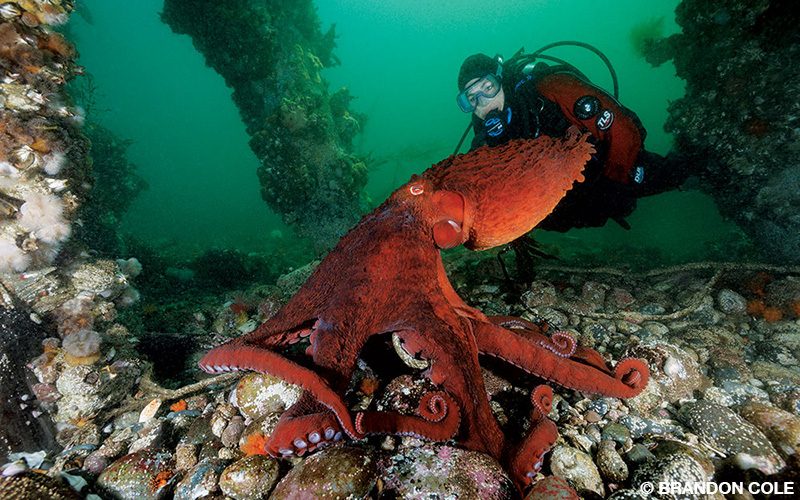
GPOs have gently probed my mask with suckered tentacles and not-so-gently wrestled me. Immensely strong, a spirited beast — I’d guesstimate a 12-footer — latched onto my camera with tentacles of steel and tried to pull it (and me) into its shadowy lair. Only by fully extending my camera rig’s strobe arms so they spanned across the crevice opening could I halt forward momentum and prevent the disappearance of the tool of my trade. After tense moments during which I swear I saw the aluminum arms bending, the octopus apparently lost interest in this game, released its grip and retreated. What a fantastic dive!
I blundered into my largest octopus to date — perhaps 20 feet from tentacle tip to tentacle tip — in Puget Sound’s southerly reaches at a site aptly named Octopus Hole. Sadly, I have no photo to prove the proportions of this tale. It occurred long ago, in the Precambrian murk of the film era, and I was in the most lamentable of positions: out of film, having regrettably spent precious frame number 36 photographing plumose sea anemones. To their credit, they were impressive specimens at 3 feet tall but not in the same league as the mother of all devilfish.
Cameras took over my life, becoming intricately woven into the story of my search for Mr. Big. Photography helped other people somewhat rationalize why I spent weeks on end each summer following the resident killer whales around Washington’s sheltered seas in my Zodiac boat — my job was to document marine wildlife with my camera, after all. That I would have made the same yearly pilgrimages to revisit family pods J, K and L without photo gear just to be in their presence might have been harder to justify to non-whale-huggers.
This was something I simply had to do; it was so fascinating and fulfilling that I knew I had found my place in the cosmos. I could recognize individual orcas by their dorsal fin profile or the shape and coloration of their saddle patch (a unique whitish-gray marking behind the dorsal fin). I memorized their genealogy. I grew adept at interpreting their behaviors and anticipating when they were likely to breach, spy-hop, socialize with others or lollygag in a kelp bed.
And I was fast and accurate with my telephoto lens. One picture would be published hundreds of times worldwide. That piece of cellulose helped lay the foundation upon which I would build my name as a waterman specializing in charismatic megafauna.
British Columbia: Fertile Grounds for Sizeable Species
With the halcyon days of my killer whale forays often carrying me over an invisible border of little significance to the critters, it was only natural for me to explore the waters of British Columbia, Canada. Vancouver Island became a second home to me. The rocky reefs are incredibly lush, dive-site diversity is world class, and the variety of large life forms boggles the mind. There are orcas, Pacific white-sided dolphins, humpback whales, lingcod as big as my wife and wolf eels longer than me. If you’re really lucky, you may bump into the elusive sixgill shark, an ancient elasmobranch that can grow longer than my wife and me put together. For those seeking an eight-armed embrace, fear not; giant octopuses lord it over the local Canuck invertebrates.
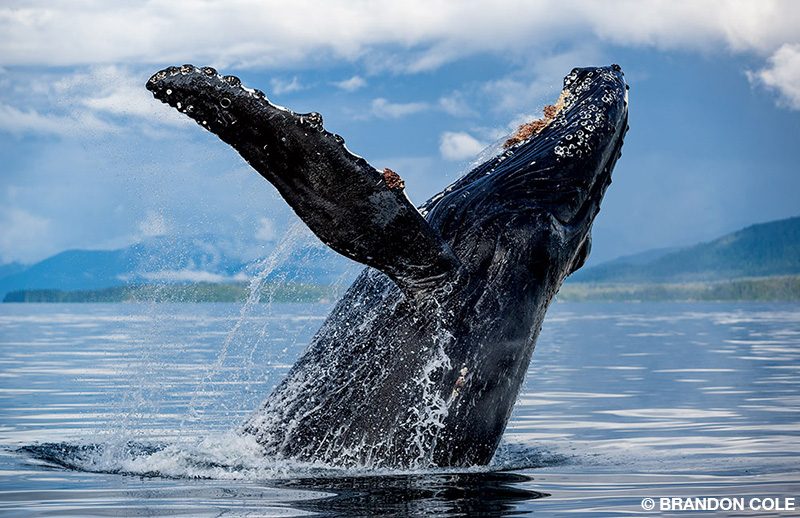
For those divers seeking a warm-blooded cuddle, dozens of Steller sea lions enthusiastically welcome visitors during winter months. Very enthusiastically. An encounter with these playful puppies is an exciting, tactile experience and sometimes even a full-contact sport. The adults, especially the bulls, are massive and make your heart race when a whiskered, aquatic sasquatch materializes out of the gloom. It’s usually cute 6- to 8-foot-long babies and juveniles, however, that hug you with their fore flippers, mischievously tug strobe cables or even pull at your hood with alarmingly sized, prematurely yellowing teeth. When really worked up, the boisterous gang has been known to mob divers, piling on a dozen strong, and they occasionally use their human playmates as chew toys. If you enjoy being the center of attention and aren’t worried about a crowd encroaching on your personal space, then this dive is for you. Personally, I love a good rugby scrum with the “dogs,” but other people may prefer less-exuberant dive buddies.
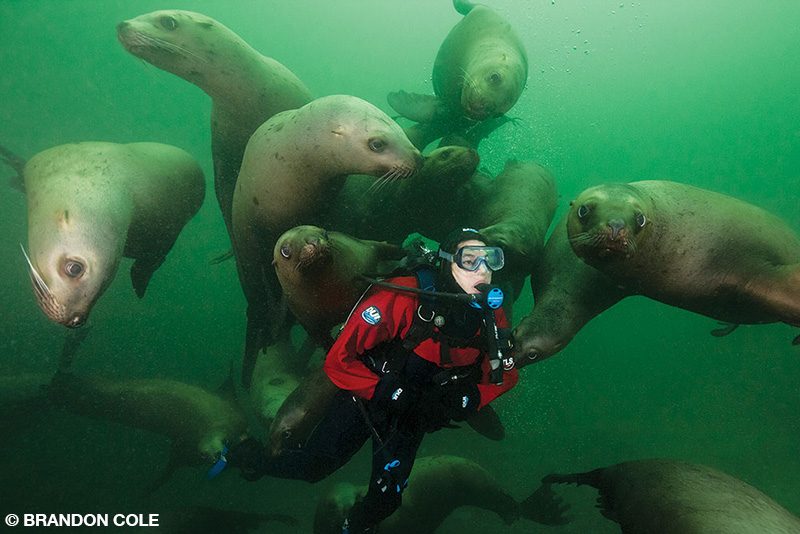
California: Golden Opportunities
West Coasters are fortunate to have so many oversized marine species in the area. Early on, when funds were severely limited for overseas air travel — not long after my financially challenged Top Ramen™ college years, I made numerous expeditions to California by car. Along the way I’d often make a quick stop in Depoe Bay, Oregon, to hop on a whale-watching boat for gray whales. Reenergized as always by the leviathan phenomenon, I’d continue onward and downward to California.
The Golden State’s temperate waters are replete with big animals. Monterey Bay in Northern California offers superb scuba diving as well as remarkable topside marine mammal viewing. The biggest of the baleen whales aggregate here in summer and fall months to feast on krill and baitfish. Visitors on eco-cruises into the bay regularly see blues, finbacks and humpbacks aplenty. Humpbacks put on a spectacular show, lunging and bubble-net feeding with gusto and then burning off calories by throwing around some seriously prodigious weight. The physics involved in gracefully hurling 30 tons above the waves in a full-body spinning breach defies gravity and my understanding.
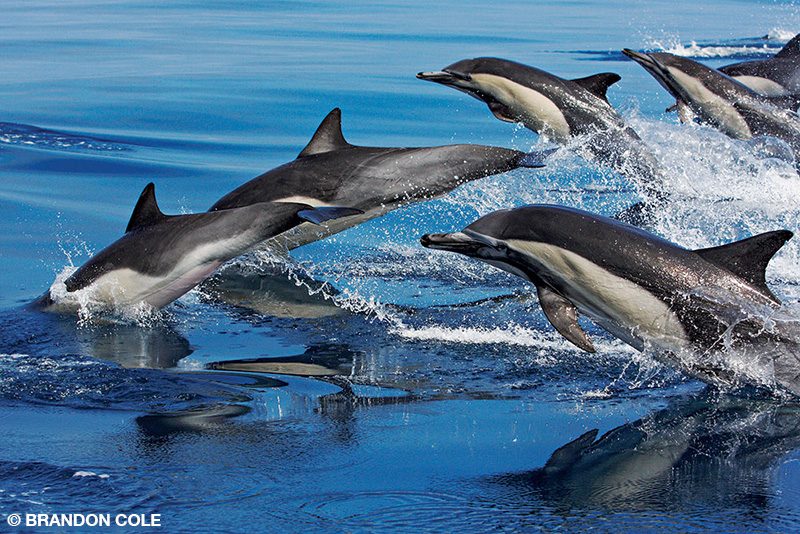
Transient killer whales visit the bay during spring to hunt gray whales migrating north from wintertime calving grounds in Baja. Forever etched in my mind is the day I photographed orcas separate a mother gray whale from her calf and then with brutal efficiency orchestrate a fatal attack on the defenseless baby. This raw and uncensored Natural Geographic moment remains the most traumatic and unforgettable natural history event I’ve ever experienced. Other days, such as when I’m whooping with joy as common dolphins race alongside my boat or enjoying happy times cavorting with California sea lions (mild-mannered pipsqueaks compared to the Stellers in BC) on easy shore dives off the breakwater, provide smiling, feel-good memories that help to balance the pain of watching killer whales earn their namesake.
The Marine Mammal Protection Act prohibits people from swimming with whales in U.S. waters, and Canada has similar regulations as well. The best way to experience the big, blubbery action is to join a permitted whale-watching excursion, stay topside and arm yourself with a telephoto lens of at least 300mm focal length. Many such boat tours depart Southern California ports from Santa Barbara to San Diego, where it’s likely you’ll see baleen whales and dolphins. Imagine hundreds — sometimes thousands — of common dolphins churning the surface as far as the eye can see. I carry a topside camera even if I’m on a dive charter rather than a dedicated marine mammal tour.
Southern California has plenty of megafauna at which to point my underwater camera. Giant black sea bass lurk in the kelp forests bordering the Channel Islands. Gentle and gigantic, these lunkers stretch to 7 feet in length and weigh hundreds of pounds. Once hunted nearly to extinction, they’ve been officially protected since 1982 and are now recovering slowly. The open water offshore San Diego can be productive for pelagics from spring through fall. I’ve photographed svelte blue sharks and twitchy makos with the help of an irresistible chumsicle lure.

If you see floating kelp adrift in the middle of nowhere, quietly slide in on snorkel. Kelp paddies often hide gold underneath in the form of a Mola mola. A slow approach may reward you with quality facetime with one of the ocean’s weirdest fish: a google-eyed, open-mouthed jellyfish predator that appears to be missing the rear half of its body and still grows to the size of a kitchen table.
It pays to investigate any towering spouts erupting from the sea surface near the Coronado Islands just south of the border because blue whales often hang around there in the summertime. Since you’ll no longer be in American but in Mexican waters, that ultimate opportunity for underwater footage of the ocean’s largest-ever animal may be within reach.
Manitoba: The Great White North
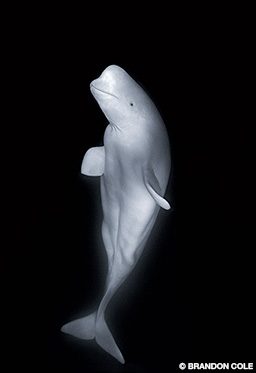
The Pacific Ocean holds a lifetime and more worth of marine megafauna encounters, but it’s only the tip of the iceberg. Before surveying North America’s Eastern seaboard, let’s detour north to Churchill, Manitoba, which is famous as the polar bear capital of the world. Thousands of tourists from across the globe watch ice bears from the safety of tundra buggies in late fall. People also come to this remote Canadian outpost on Hudson Bay during summer to see beluga whales along the shoreline and in the Churchill River. Curious and gregarious, belugas love to follow slowly moving Zodiacs.
Current regulations prevent swimming with the white whales, but amazing underwater photo opportunities are still very much achievable. Lying belly-down on the pontoon and sticking my camera in 38°F water was all it took to capture imagery of belugas glowing in the gloom. One animal seemed entranced with my camera, or perhaps enamored of its own reflection, and repeatedly pressed its spongy forehead onto my dome port. On another day I was favored with a swim-by from a mother and her newborn calf, only a few feet long and still gray-brown in color. When I return to Churchill I will bring a GoPro for auto-everything, no-brain-involved video and a camera pole to easily submerge my other camera and housing a bit deeper.
Florida: A Target-Rich Environment
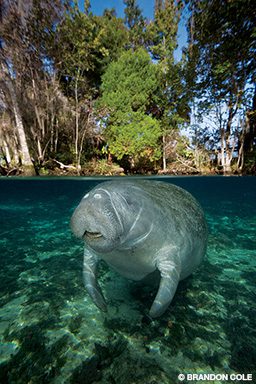
No ocean odyssey with the purpose to rub flippers and fins with the stars would be complete without visiting Florida. Headlining the cast of characters living here are manatees in the Crystal River area on the Gulf of Mexico side. I like to think of them as smiling potatoes with flippers. They’re among the most endearing aquatic animals and perhaps the easiest to encounter. Grab a snorkel, mask and thick wetsuit (even with 72°F water bubbling up from the springs, brisk wintertime morning air temps can make this a chilly affair), join an organized tour or rent your own jon boat or kayak, and wait. Sooner or later a manatee will roll over belly-up or perform other ungainly acrobatics, lumber over to lean against you trustingly or just stare at you with tiny, soulful button eyes nearly lost amid its wrinkles and whiskers.

Off Florida’s Atlantic coast, charter boats take divers to shipwrecks around which man-sized goliath groupers aggregate in autumn, sometimes in groups of 10 or more. This equates to serious biomass. The diving can be challenging at times due to strong currents and some depths around 100 feet. Goliath groupers occasionally visit shallower, nearshore reefs that are more accessible for less-experienced divers. You’ll likely meet huge, ancient loggerhead turtles as well. Folks have even seen the much rarer and even larger leatherback turtles gliding through the blue when the stars align perfectly.
Shark junkies rejoice that operators out of Jupiter, Florida, that cater to experienced divers have amassed an impressive record conjuring forth multiple species sure to boost adrenalin and fill camera memory cards. I’ve seen lanky lemons, girthy bulls (up to eight at one time) and, at the top of the hierarchy, imperious tiger sharks. The Caribbean reef sharks and nurse sharks buzzing around hardly register in such weighty company.
North Carolina: Ships Full of Snaggleteeth
Morehead City, North Carolina, proves that if you sink it, they will come. This wreck-diving mecca is a magnet for rust-loving metalheads. Many of the sunken vessels are victims of World War II; others were more recently sent to the bottom on purpose as part of the state’s artificial reef program. The fleet of slumbering giants also attracts sand tiger sharks. I revel in spelunking through maritime history, even more so when I’m surrounded by sharks.
The sand tiger is one of my favorite homegrown charismatic megafauna species. What’s not to like about a sinister-looking shark sporting diabolical dentition that also happens to be easily approached and safely admired? No chum is needed to draw in Carcharias taurus. The complex structure provided by wrecks undoubtedly is partly responsible for their presence, but the sharks aren’t saying why else they favor the Graveyard of the Atlantic.
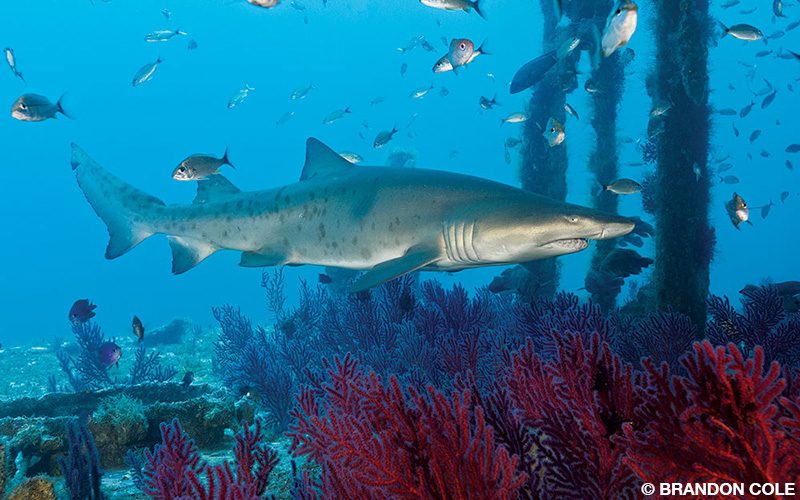
Summertime, when the water warms and clears, is prime time for North Carolina shark diving. This is when I’ve found packs of sand tigers patrolling the tween deck and keyhole room of the cable-layer Aeolus and clouds of shimmering baitfish through which waves of the slack-jawed sharks pass, orbiting the 450-foot-long Atlas tanker, which was torpedoed by a German U-boat in 1942 and now rests at 125 feet. The Spar, Caribsea and Papoose wrecks have also given me superb dives chock-full of toothy dive buddies.
Rhode Island: The Next Chapter
I have not yet visited Rhode Island, but the vast green-blue Atlantic on its doorstep is arguably the premier place in North America to come face-to-face with a shortfin mako or multiple blue sharks. To tide me over until I can experience this encounter firsthand, I contacted professional photographer Bill Fisher. His hundreds of submersions over 12 years and a sixth sense for knowing just when to snap the shutter have helped him create a killer portfolio.
“Many of my most exciting encounters have occurred in midsummer, some 30-ish miles offshore,” Fisher explains. “Local operators expertly read the water and bring sharks in close with just the right chum.” He prefers snorkel over scuba because it facilitates getting on and off the boat easily and quietly. Blue sharks can become quite comfortable around people and hang around for hours, but some individuals, especially makos, may be frightened away by noise, splashing and sudden movements. It’s important to stay calm and let the sharks come to you, all while you maintain awareness of the boat, bait and other sharks.
With visions of sinuous, airplane-winged blue sharks and metallic-sheened, grim-visaged makos dancing in my head, I ask Fisher for some mako photo tips. He kindly obliges and shares a treasure trove of wise words.
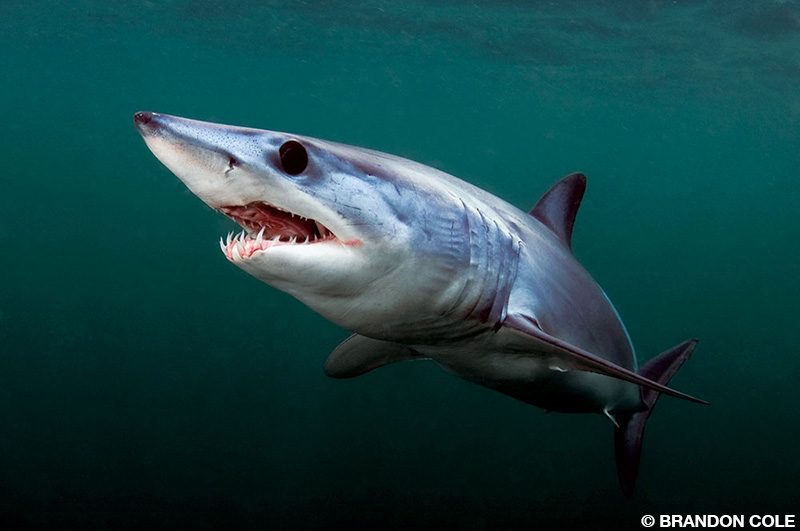
“Lightning quick, makos can charge onto the scene at warp speed, so be ready to fire away, from the hip if necessary,” he says. “I wear enough weight to easily sink down a few feet. I like to compose with an upward angle — great for dramatic portraits. If I don’t have time to submerge, I’ll extend my arms down and then point the camera up a bit. Don’t waste any opportunity to shoot; moments may be fleeting.
“This is high-energy stuff, up close and personal, and sometimes visibility is limited,” he continues. “I use the Tokina 10-17mm zoom fisheye lens. Remember to frequently wipe your dome to remove microbubbles. I’ll choose manual metering when the situation is mellow or aperture priority if the action is crazy or ambient light levels are changing. Crank up the shutter speed to 1/250 or 1/320 of a second, and power down strobes for fast recycling and to prevent overexposing the mako’s reflective skin.”
He recounted an extremely rare sighting of a baby blue shark barely 2 feet long and a session with at least 10 blues circling him. On another day a true monster mako, 13 or 14 feet long, made a heart-stopping appearance. “It’s a big ocean out there, full of surprises,” he says. “You never know what you’ll see, like that time when a breaching basking shark surprised us.”
Inspired by Fisher’s stories, I recommit to traveling to Rhode Island as soon as possible. I need to experience such megafauna magic for myself. It’s past time for me to wash up on this not-so-distant shore. After that, who knows? I am certain, however, that my endless summer road trip is far from over. With the persistence of the tides, I will continue to ebb back and forth from coast to coast, questing for all creatures great and small — leaning heavily toward greatness, of course — swimming close to home.
© Alert Diver — Q3 Summer 2019